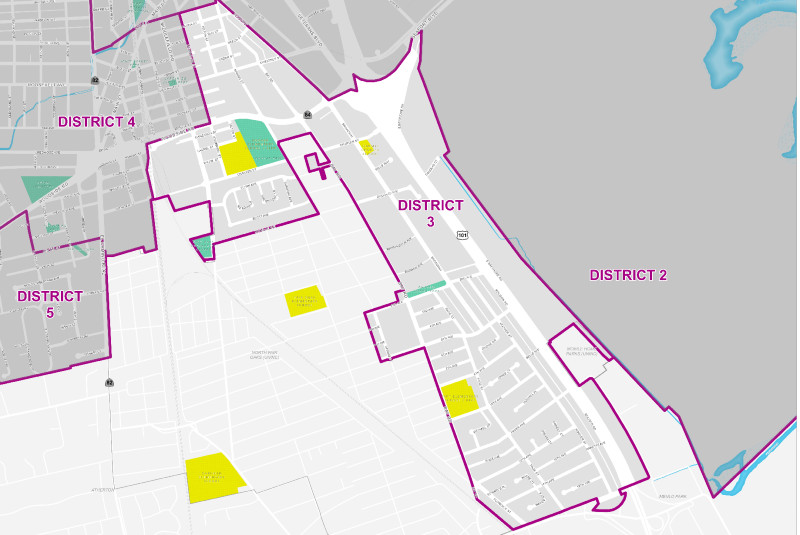The race for the District 3 seat on the Redwood City Council may put to test the longstanding political truism that all politics are local.
It is one of two districts that are minority-majority – 71 percent Hispanic. It is the home neighborhood of Councilmember Janet Borgens, raised in East Palo Alto and a resident of the district for 37 years. She notes that she is not Hispanic, but argues she is deeply ingrained in the community and that her own working-class background has kept her in touch with the challenges and concerns of District 3 residents.
“This is the kind of community I was raised in. I may be White privilege, but I wasn’t raised White privilege. … My community has known what I’ve been doing for many, many years and they’ll either want that to continue or they won’t,” she said.
She is being challenged by two candidates who contend that the district residents want more bold and non-establishment leadership.
Isabella Chu, a Stanford public health researcher and founder of Redwood City Forward, has been a high-profile advocate for dramatically more housing in the city. “We need more housing,” she said. “It should go all over the city. Yes to higher density. Yes to more height.” Like Borgens, Chu is not Hispanic. “I don’t think you have to be Latino to understand them and to represent them,” she said. Her goal, she said, is to “disrupt the status quo.”
Lissette Espinoza-Garnica is a professional caregiver, self-designated as nonbinary gender and the only Hispanic in the 2020 city council race seeking an “Hispanic” seat. They grew up in Redwood City and North Fair Oaks and moved to the district’s Friendly Acres as a child. “I’ve grown up here. It’s not Jim Crow era segregation, but it’s still very segregated – where the wealth is, where the people of color are,” they said. The answer is to completely remake the status quo. “I see that the people running right now are very much establishment … I’m running because it’s a crisis and I really want to ensure security for my community, especially those who have been neglected for so long.”
District 3 is at the southern edge of the city, bounded by Woodside Road, Maple Street, Bay Road and Broadway. It includes the neighborhoods of Friendly Acres, Stambaugh-Heller and Redwood Village. Forty-six percent of residents are immigrants, 65 percent speak Spanish at home and 40 percent say they speak English “less than very well” – all categories that are the highest in the city. Forty-two percent of households have an income under $50,000, and renters outnumber homeowners almost 2-1.

If the fundamental political question is who best represents the residents of District 3, the fundamental policy question is housing. All three candidates agree that the district struggles with housing insecurity, overcrowding and housing costs that force multiple families to live together, or that force them to leave the city.
Chu wants sweeping changes to the city’s housing policies and practices. “Our built environment looks like it did in the 1950s. In the last 70 years, Redwood City has tripled in population,” Chu said. “I’m willing to see our neighborhoods adapt to the 21st century. Homeowners should be able to change their homes, have smaller setbacks” and additional stories. “Things have changed. The buildings have stayed the same.”
As an example of the kind of sweeping change she would support, Chu said the 17-story proposal for Sequoia Station, at El Camino Real and Jefferson Avenue, “is extremely modest. Come on, it’s 2020, we’re in Silicon Valley. … This is some of the most valuable land in the world. If the city had been allowed to develop organically, based on need, we’d have a ton of high-rise buildings. … most residences would be 3-5 stories.”
The city’s “shortness of buildings” is “emblematic of tremendous resistance,” she said. “There’s an idea that because a small group of people is very vocal and good at wielding power that they’re the majority. … Half the city’s population is renters. The other half own homes – 25-30 percent would be happy to add on to their homes, 25-30 percent just wouldn’t care.”
Espinoza-Garnica supports a corporate “head count” tax to raise revenues to build more housing, including public housing and more low-income housing. “It’s not enough to have only market-rate housing. We have to have secure housing, mixed, subsidized housing and definitely provide housing for all,” Espinoza-Garnica said. That includes workforce housing so “the people who work here are able to live here.”
Borgens said, “Housing needs to be built where the need is. … Look in my district, you have 3-4 families living together. Build affordable, for-sale housing in any district across town. If we can help our most vulnerable communities buy housing, that’s housing security.”
She envisions a broad range of housing – duplexes, triplexes, small units that can be added to a second story or a backyard. “Build housing where it’s needed and my district needs it,” she said, and the specific need is for family-oriented housing. “Why do we think low-income people all want to be crowded together in a high-rise apartment building?” she said. “I don’t support public housing. I support mixed housing – mix all levels of income together.”
Perhaps more than in other districts, the issue of policing is of paramount importance in the tight-packed, minority-minority District 3.
“I’m an abolitionist,” said Espinoza-Garnica, “and this platform is looking to defund the police so they’re not required to respond to the community as much anymore.” If the money spent on policing was spent on more and improved housing, higher employment, universal child care, rapid rehousing of those who lose their homes to economic difficulties and essential support services, it would reduce crime and reduce the need for police presence in a community that feels estranged from law enforcement, they said.
“I’m for descoping and divesting and defunding the police and try to limit the amount of interaction of police with residents,” Espinoza-Garnica said. “Policing is inherently racist, corrupt and is only there to punish people for being poor, black, brown, and having to survive a capitalist system. I’m all about defunding the police in order to address ways to reduce harm.”
Defunding the police is a means to end “centuries of anti-Black racism and oppression of gender and the working class” and bias toward “high-earners, business owners, land owners.”
Borgens said, “I am not a defund the police [supporter], but I understand that is the wrong phrase. I do support revisiting how we provide policing services and if those services are best served by an adding on in the mental health component.” Her focus is on transparency and cracking down on police officers who repeatedly use excessive force, but she wants to see how a citizens oversight commission might be structured before taking a position.
“I have no problem holding our police accountable and if a citizens oversight committee is the right way to go, I’m not against it. If you’re following the rules, there’s no reason you should be concerned about oversight,” she said.
“We have to weed out the bad apples.” Borgens said. “We can sit here and say with naivete we don’t have any bad apples, it’s been dealt with in-house.”
Chu said a number of police duties should be reassigned or reinvented. Traffic enforcement can be fully automated, for example, which would eliminate what she called “income bias.” The social responsibilities handled by the police – mental health issues, homelessness, domestic problems – can be handed off to the state or the county and more effectively managed by agencies designed for those purposes. “I’m perfectly willing to look at what (police) do, whether it should be done by an agent of the state and whether it can be done more cost effectively,” she said.
Chu said she supports more citizen oversight and more transparency, including tracking how police personnel are deployed. “Most police have nothing to fear from that. If they’re policing fairly, not hurting people, they have nothing to fear,” she said.
The issue likely to dominate the attention of a new council almost immediately, however, will be the city’s large budget deficit, driven by the economic disruption caused by the Covid-19 pandemic and associated loss of sales tax revenues and local business declines.
Responding will require more efficient use of available resources, Borgens said, citing as an example how the parks and recreation services were reinvented during the shelter-in-place requirements. She said there is likely to be a hiring freeze, although she said, “I don’t think any of our police and fire are overstaffed. Both can come to the table.”
Corporate partnerships to support some essential services may be a constructive next step, along with the possibility of finding a way to tax revenues generated in online sales, she said.
Chu said the city needs to do more to measure the effectiveness of its spending and to require city departments, in essence, to apply for their funding and justify their budgets.
“Are we getting the most value,” Chu said. The city is going to have to look for additional sources of revenue, she said. And her proposals for greater housing density allows more concentration of city services, which can save money.
Espinoza-Garnica’s view on the budget stems from a fundamental conviction that the city needs to be radically changed. The budget is a statement on the city’s priorities, they said, and the focus should be on affordable housing for all and making sure every resident is making a living wage.
“We need to reprioritize the budget to think about the most vulnerable,” Espinoza-Garnica said.
Contact Mark Simon at mark.simon24@yahoo.com.
*The opinions expressed in this column are the author’s own and do not necessarily reflect the views of Climate Online.






